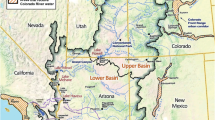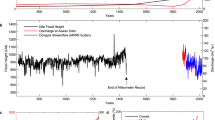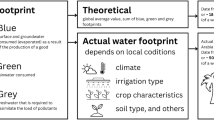Abstract
Water stress is often evaluated by scarcity: the share of available water supply being consumed by humans. However, some consumptive uses of water are more or less flexible than others, depending on the costs or effects associated with their curtailment. Here, we estimate the share of global water consumption over the period 1980–2016 from the relatively inflexible demands of irrigating perennial crops, cooling thermal power plants, storing water in reservoirs and supplying basic water for humans and livestock. We then construct a water stress index that integrates the share of runoff being consumed (scarcity), the share of consumption in these inflexible categories (flexibility) and the historical variability of runoff weighted by storage capacity (variability), and use our index to evaluate the trends in water stress of global major river basins on six continents. We find that the 10% most stressed basins encompass ~19%, 19% and 35% of global population, thermal electricity generation and irrigated calorie production, respectively, and some of these basins also experience the largest increases in our identified stress indexes over the study period. Water consumption intensities (water used per unit of goods or service produced) vary by orders of magnitude across and within continents, with highly stressed basins in some cases characterized by high water consumption intensities. Our results thus point to targeted water mitigation opportunities (for example, relocating crops and switching cooling technologies) for highly stressed basins.
This is a preview of subscription content, access via your institution
Access options
Access Nature and 54 other Nature Portfolio journals
Get Nature+, our best-value online-access subscription
$29.99 / 30 days
cancel any time
Subscribe to this journal
Receive 12 digital issues and online access to articles
$119.00 per year
only $9.92 per issue
Buy this article
- Purchase on Springer Link
- Instant access to full article PDF
Prices may be subject to local taxes which are calculated during checkout





Similar content being viewed by others
Data availability
Data used to perform this work can be found in the Supplementary Information. Any further data that support the findings of this study are available from the corresponding authors upon reasonable request.
Change history
19 June 2019
In the version of this Analysis originally published, in the section ‘Trends in global water demand’, the percentage increase in agricultural area equipped for irrigation was incorrect: the text ‘rose by 48% from 270 to 400×106 ha’ should have read ‘rose by 50% from 220 to 330×106 ha’; this has now been corrected.
References
Brauman, K. A., Richter, B. D., Postel, S., Malsy, M. & Florke, M. Water depletion: an improved metric for incorporating seasonal and dry-year water scarcity into water risk assessments. Elem. Sci. Anth. 4, 000083 (2016).
Oki, T. & Kanae, S. Global hydrological cycles and world water resources. Science 313, 1068–1072 (2006).
Postel, S. L., Daily, G. C. & Ehrlich, P. R. Human appropriation of renewable fresh water. Science 271, 785–788 (1996).
Schewe, J. et al. Multimodel assessment of water scarcity under climate change. Proc. Natl Acad. Sci. USA 111, 3245–3250 (2014).
Vorosmarty, C. J., Green, P., Salisbury, J. & Lammers, R. B. Global water resources: Vulnerability from climate change and population growth. Science 289, 284–288 (2000).
Jackson, R. B. et al. Water in a changing world. Ecol. Appl. 11, 1027–1045 (2001).
Prudhomme, C. et al. Hydrological droughts in the 21st century, hotspots and uncertainties from a global multimodel ensemble experiment. Proc. Natl Acad. Sci. USA 111, 3262–3267 (2014).
Mazdiyasni, O. & AghaKouchak, A. Substantial increase in concurrent droughts and heatwaves in the United States. Proc. Natl Acad. Sci. USA 112, 11484–11489 (2015).
Hoekstra, A. Y., Mekonnen, M. M., Chapagain, A. K., Mathews, R. E. & Richter, B. D. Global monthly water scarcity: blue water footprints versus blue water availability. PLoS ONE 7, 32688 (2012).
Wada, Y. et al. Global monthly water stress: 2. Water demand and severity of water stress. Water Resour. Res. 47, W07518 (2011).
Zhang, C., Zhong, L., Fu, X., Wang, J. & Wu, Z. Revealing water stress by the thermal power industry in China based on a high spatial resolution water withdrawal and consumption inventory. Environ. Sci. Technol. 50, 1642–1652 (2016).
Florke, M. et al. Domestic and industrial water uses of the past 60 years as a mirror of socio-economic development: A global simulation study. Glob. Environ. Change 23, 144–156 (2013).
Rosenzweig, C. et al. Assessing agricultural risks of climate change in the 21st century in a global gridded crop model intercomparison. Proc. Natl Acad. Sci. USA 111, 3268–3273 (2014).
Greve, P. et al. Global assessment of water challenges under uncertainty in water scarcity projections. Nat. Sustain. 1, 486–494 (2018).
Davis, S. J., Caldeira, K. & Matthews, H. D. Future CO2 emissions and climate change from existing energy infrastructure. Science 329, 1330–1333 (2010).
Tortajada, C., Kastner, M. J., Buurman, J. & Biswas, A. K. The California drought: Coping responses and resilience building. Environ. Sci. Policy 78, 97–113 (2017).
Newbery, D. M. Competition, Contracts, and entry in the electricity spot market. RAND J. Econ. 29, 726–749 (1998).
Wittwer, G. Multi-regional Dynamic General Equilibrium Modeling of the U.S. Economy. Advances in Applied General Equilibrium Modeling (ed. Wittwer, G.) Ch. 30 (Springer, 2017).
Gelaro, R. et al. The modern-era retrospective analysis for research and applications, version 2 (Merra-2). J. Clim. 30, 5419–5454 (2017).
Kaygusuz, K. Energy services and energy poverty for sustainable rural development. Renew. Sust. Energy Rev. 15, 936–947 (2011).
Andrews-Speed, P. & Dow, S. Reform of China’s electric power industry - challenges facing the government. Energy Policy. 28, 335–347 (2000).
van Vliet, M. T. H., Wiberg, D., Leduc, S. & Riahi, K. Power-generation system vulnerability and adaptation to changes in climate and water resources. Nat. Clim. Change 6, 375 (2016).
Beatty, M. E., Phelps, S., Rohner, C. & Weisfuse, I. Blackout of 2003: Public health effects and emergency response. Public Health Rep. 121, 36–44 (2006).
Fogden, J. & Wood, G. Access to safe drinking water and its impacts on global economic growth (HaloSource Inc, 2009).
Yuksel, I. Hydropower for sustainable water and energy development. Renew. Sust. Energ. Rev. 14, 462–469 (2010).
Siebert, S. & Doll, P. Quantifying blue and green virtual water contents in global crop production as well as potential production losses without irrigation. J. Hydrol. 384, 198–217 (2010).
Food and Agriculture Data (FAO, 2018); http://www.fao.org/faostat/en/#data
World Electric Power Plants (WEPP) Database 2017 Version (S&B Global Platts, 2018); https://www.spglobal.com/platts/en/products-services/electric-power/world-electric-power-plants-database
Lehner, B. et al. Global Reservoir and Dam (GRanD) Database. Technical Documentation Version 1 (SEDAC, 2011); http://sedac.ciesin.columbia.edu/data/set/grand-v1-dams-rev01
Global Runoff Data Centre: GGRDC_405_basins_from_mouth. GRDC in the Bundesanstalt fuer Gewaesserkunde, 56068 Koblenz, Germany (GRDC, 2007); https://www.bafg.de/GRDC/EN/02_srvcs/22_gslrs/221_MRB/basin_delineation.html
Portmann, F. T., Siebert, S. & Doll, P. MIRCA2000—Global monthly irrigated and rainfed crop areas around the year 2000: a new high-resolution data set for agricultural and hydrological modeling. Global Biogeochem. Cycles 24, GB101 (2010).
Davis, K. F. et al. Alternative cereals can improve water use and nutrient supply in India. Sci. Adv. 4, eaao1108 (2018).
Jägermeyr, J. et al. Integrated crop water management might sustainably halve the global food gap. Environ. Res. Lett. 11, 025002 (2016).
Brauman, K. A., Siebert, S. & Foley, J. A. Improvements in crop water productivity increase water sustainability and food security—a global analysis. Environ Res. Lett. 8, 024030 (2013).
MacDonald, G. K., D’Odorico, P. & Seekell, D. A. Pathways to sustainable intensification through crop water management. Environ Res. Lett. 11, 091001 (2016).
Barnes, G. T. The potential for monolayers to reduce the evaporation of water from large water storages. Agric. Water Manag. 95, 339–353 (2008).
Martinez-Granados, D., Maestre-Valero, J. F., Calatrava, J. & Martinez-Alvarez, V. The Economic impact of water evaporation losses from water reservoirs in the Segura Basin, SE Spain. Water Resour. Manag. 25, 3153–3175 (2011).
Alvarez, V. M., Baille, A., Martinez, J. M. M. & Gonzalez-Real, M. M. Efficiency of shading materials in reducing evaporation from free water surfaces. Agric. Water Manag. 84, 229–239 (2006).
Sahu, A., Yadav, N. & Sudhakar, K. Floating photovoltaic power plant:a review. Renew. Sust. Energy Rev. 66, 815–824 (2016).
Wurbs, R. A. & Ayala, R. A. Reservoir evaporation in Texas, USA. J. Hydrol. 510, 1–9 (2014).
Santafe, M. R. et al. Implementation of a photovoltaic floating cover for irrigation reservoirs. J. Clean. Prod. 66, 568–570 (2014).
Baldassarre, G. D. et al. Water shortages worsened by reservoir effects. Nat. Sustain. 1, 617–622 (2018).
Zhang, C., Anadon, L. D., Mo, H. P., Zhao, Z. N. & Liu, Z. Water–Carbon trade-off in China’s cCoal power industry. Environ. Sci. Technol. 48, 11082–11089 (2014).
Qin, Y. et al. Air quality–carbon–water synergies and trade-offs in China’s natural gas industry. Nat. Sustain. 1, 505–511 (2018).
Wada, Y. et al. Global depletion of groundwater resources. Geophys. Res. Lett. 37, L20402 (2010).
Gleeson, T., Wada, Y., Bierkens, M. F. P. & van Beek, L. P. H. Water balance of global aquifers revealed by groundwater footprint. Nature 488, 197–200 (2012).
Richts, A., Struckmeier, W. & Zaepke, M. in Sustaining Groundwater Resources (ed. Jones, J.) 159–173 (Springer, 2011).
van der Ent, R. J. & Savenije, H. H. G. Length and time scales of atmospheric moisture recycling. Atmos. Chem. Phys. 11, 1853–1863 (2011).
McDonald, R. I. et al. Water on an urban planet: Urbanization and the reach of urban water infrastructure. Glob. Environ. Chang. 27, 96–105 (2014).
Carbon Monitoring for Action (CARMA) Database (Center for Global Development, 2009); http://carma.org
The Emissions and Generation Resource Integrated Database (eGRID) (Environmental Protection Agency, 2014); https://www.epa.gov/energy/emissions-generation-resource-integrated-database-egrid
Free World Cities Database (MaxMind, accessed January 2018); https://www.maxmind.com/en/free-world-cities-database
Delgado, A. & Herzog, H. J. A Simple Model to Help Understand Water Use at Power Plants (Massachusetts Institute of Technology Energy Initiative, 2012).
Fricko, O. et al. Energy sector water use implications of a 2 °C climate policy. Environ. Res. Lett. 11, 034011 (2016).
What is the Minimum Quantity of Water Needed? (WHO, accessed 23 January 2019); https://www.who.int/water_sanitation_health/emergencies/qa/emergencies_qa5/en/
Alcamo, J., Döll, P., Kaspar, F. & Siebert, S. Global Change and Global Scenarios of Water Use and Availability: An Application of WaterGAP1.0 (CESR, 1997).
Goldewijk, K. K., Beusen, A., Doelman, J. & Stehfest, E. Anthropogenic land use estimates for the Holocene – HYDE 3.2. Earth Syst. Sci. Data 9, 927–953 (2017).
Robinson, T. P. et al. Mapping the global distribution of livestock. PLoS ONE 9, e96084 (2014).
The NCAR Command Language v.6.6.2 (NCAR, 2019); https://doi.org/10.5065/D6WD3XH5
Acknowledgements
Y.Q., C.H. and S.J.D. were supported by the US National Science Foundation (INFEWS grant EAR 1639318). We acknowledge helpful discussions with C. McIntosh.
Author information
Authors and Affiliations
Contributions
S.J.D., N.D.M., R.B.J., J.B.Z. and Y.Q. designed the study. Y.Q. performed the analyses, with additional support from S.S., A.A. and D.T. on datasets and S.S., C.H. and D.T. on analytical approaches. Y.Q., S.J.D., N.D.M., R.B.J. and J.B.Z. led the writing with input from all co-authors.
Corresponding author
Ethics declarations
Competing interests
The authors declare no competing interests.
Additional information
Publisher’s note: Springer Nature remains neutral with regard to jurisdictional claims in published maps and institutional affiliations.
Supplementary information
Supplementary Information
Supplementary Methods, Supplementary References 1–79, Supplementary Tables 1–7 and Supplementary Figs. 1–7.
Supplementary Dataset 1
Spreadsheet of data that allows readers to use their own preferred weighting schemes to generate the resulting new water stress indexes for global basins.
Rights and permissions
About this article
Cite this article
Qin, Y., Mueller, N.D., Siebert, S. et al. Flexibility and intensity of global water use. Nat Sustain 2, 515–523 (2019). https://doi.org/10.1038/s41893-019-0294-2
Received:
Accepted:
Published:
Issue Date:
DOI: https://doi.org/10.1038/s41893-019-0294-2
This article is cited by
-
Global peak water limit of future groundwater withdrawals
Nature Sustainability (2024)
-
The asymmetric impacts of international agricultural trade on water use scarcity, inequality and inequity
Nature Water (2024)
-
Spatial Heterogeneity of Embedded Water Consumption from the Perspective of Virtual Water Surplus and Deficit in the Yellow River Basin, China
Chinese Geographical Science (2024)
-
Food without agriculture
Nature Sustainability (2023)
-
Prefectures vulnerable to water scarcity are not evenly distributed across China
Communications Earth & Environment (2023)



